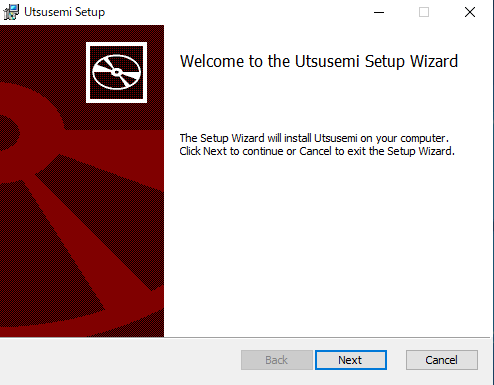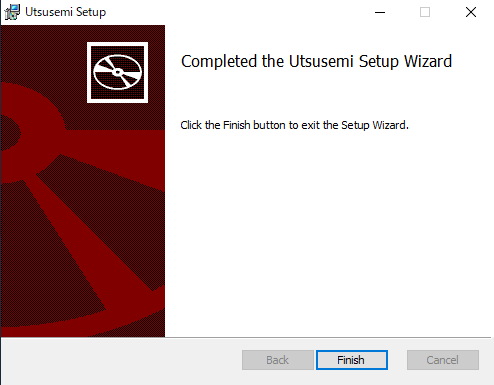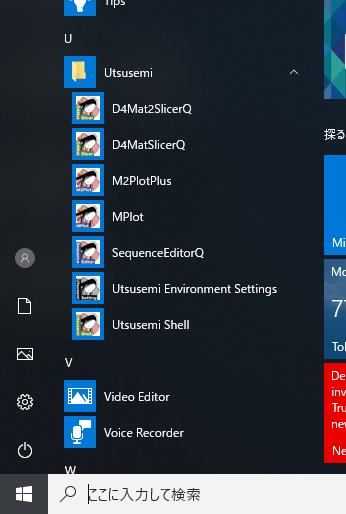Quick Installation Guide of Utsusemi for Windows#
- Author:
Yasuhiro Inamura, Ryoichi Kajimoto
- Last update:
Apr. 7th, 2023
- Utsusemi version:
4.0 or later
Requirements for Windows#
Utsusemi works on only Windows 10 and 11 64bit version. We never support 32bit version.
Account name of Windows must be constructed of English and numerical characters . If you use other character type ( Japanese, Chinese and so on ), you must create new accounts.
Installation procedures#
We have two binary installers for Windows. One is the all-in-one installer , which includes the python environment (python itself and the python libraries required from Utsusemi). The other is the minimum installer which does not include python’s environment.
All-in-one installer#
This installer is recommended for beginners.
Install Utsusemi environment (Utsusemi programs and the python environment) by the installer
Set up the environment
Minimum installer#
This installer requires users’ skills to build the required environment on linux.
Construct python environment required from Utsusemi (Python3.9, numpy, scipy, matplotlib, PySide6)
Install only Utsusemi programs by the installer
Set up the environment
Installation (all-in-one)#
In this section, we show the installation by means of the all-in-one installer. The case of the minimum installer is touched at next section.
Double clicks the installer file to install Utsusemi4.
Warning
If the previous version of Utsusemi has been installed, you must uninstall it at first.
Installation (minimum type)#
The minimum type installer is used to install the Utsusemi programs on the existing Python 3.9.x environment, as of April, 2023.
Before the installation, you need to construct the required python environment as below, but details are not mentioned.
Python3.9 and python libraries, required from Utsusemi, must be installed.
Python3.9 can be executed on a command prompt application, which is achieved by setting some environment variables.
The required Python version and packages.
the packages required by a minimum BinaryInstaller for win# Python
3.9.x
Packages
numpy, scipy, matplotlib, PySide6
Finally, the required python environment means the system in which you can launch python3.9 on a command prompt program and can import the required python packages without errors, as below.
C:\Users\hoge>python
Python 3.9.16 (main, Mar 8 2023, 10:39:24) [MSC v.1916 64 bit (AMD64)] on win32
Type "help", "copyright", "credits" or "license" for more information
>>> import numpy
>>> import scipy
>>> import matplotlib
>>> import PySide6
Installed Applications#
You will find a set of Utsusemi software in the folder given in installation process ( default is C:¥¥Program Files¥Utsusemi¥ ). And a shortcut is made at
“Start” menu -> All programs -> Utsusemi
Here, the following programs will be prepared. The details will be described later.
Applications
Description
D4MatSlicer
Launch D4MatSlicer
D4Mat2Slicer
Launch D4Mat2Slicer
M2PlotPlus
Launch M2PlotPlus
MPlot
Launch MPlot
SequenceEditor
Launch SequenceEditor
Utsusemi Environment Setting
[Environment setting] Set the environment variables for Utsusemi
Utsusemi Shell
Launch “Command Prompt” with Utsusemi environment
Set up#
Preparation (Creation of necessary folders)#
The following two folders must be prepared. These folders store raw data and temporary files.
Folder (Environment variable)
Description
Data folder (DATA_DIR)
The folder to store raw data (Same as “/data” in the Linux version.)
Analysis folder (USR_DIR)
The folder to include ana and tmp folders in which temporary files are stored (Same as “$HOME” in the Linux version)
Work folder (WORK_DIR)
The folder where you do data treatment with Utsusemi, to be used to put some Utsusemi scripts in this folder
The above two folders can be prepared in arbitrary places. For example,
Environment setting and requirements#
The initial setting of Utsusemi must be done by using Utsusemi Environment Setting .
Warning
This setting must be done at least once after the installation.
Setting items are below.
The instrument environment
Two folders to store raw data and analysis temporal information.
Logging
The number of processers for high performance on analysis
Switching debug mode
If you analyze raw data set obtained from other instrument, you must change the instrument environment in this setting.
Launch Environment Setting#
Launch Utsusemi Environment Settings from “Start” menu >> Utsusemi
Setting Items#
Setting Items |
meanings / roles |
|---|---|
Instrument |
Choose the instrument for data analysis. Raw data folder and executable commands are changed to suitable ones. |
Log quiet |
Turn on to decrease logs of analysis commands. |
Font Size |
Set the font size on GUI applications. Normaly 12 or 14 is used. Note that the increase or decrease of the size causes the disorder of GUI parts layout. |
Number of threads |
Some analysis commands are affected by this value. Normally you set the number of CPUs in your PC. |
Debug mode |
Turn on / off the debug mode of Utsusemi. Off is usually selected. |
DATA_DIR |
Folder to store raw data (Same as “/data” in the Linux version) |
USR_DIR |
Place to locate “ana” and “tmp” folders to store temporary files (Same as “$HOME” in the Linux version) |
Finishing Setting#
After setting, push OK button. Then you see confirmation dialog as below.
If you meet an error dialog instead of this, check whether the given path to two folders are existed or not.
After closing this dialog, following folders are automatically created in the folder specified by USR_DIR.
ana folder
tmp folder and xml folder under ana folder
If there is no folder above, Utsusemi Environment Settings makes these folders automatically.
Warning
If you cannot find these folders, you must make them by yourself to avoid the failure of Utsusemi launch.
On the other hand, you make folders to store raw data DATA_DIR according to a rule described in next section.
Rule for data location#
Raw data should be stored in the folder specified by DATA_DIR according to the following rule.
- Create a folder who has the same name as the instrument code.
For example, “SIK” for 4SEASONS (BL01) and “AMR” for AMATERAS (BL14).
- Place the data folder of corresponding instrument in this folder. The name of the data folder must include each Run No.
For example, “SIK012345_20150301” for 4SEASONS.
BL
Instrument code|Example of data folder
BL01 4SEASONS
SIK
DATA/SIK/SIK012345_20160401
BL11 PLANET
HPN
DATA/HPN/HPN012345_20160401
BL14 AMATERAS
AMR
DATA/AMR/AMR012345_20160401
BL15 TAIKAN
SAS
DATA/SAS/SAS012345_20160401
BL19 TAKUMI
ENG
DATA/ENG/ENG012345_20160401
Data analysis#
After completing the environment setting and preparing raw data, you can perform data analysis.
The following applications are available from “Start” menu.
- Utsusemi Environment Setting
Set and confirm the environment variables for Utsusemi. Refer to “Launch Environment Setting” section.
- MPlot, M2PlotPlus
Launch Utsusemi Plotters. Same as ones in Linux version.
MPlot
1-dimentional data plotter
M2Plot
2-dimentional data plotter and slicer
- D4MatSlicer, D4Mat2Slicer
Launch D4MatSlicer or D4Mat2Slicer, same as one in Linux version.
- SequenceEditor
Launch SequenceEditor, same as one in Linux version.
- Utsusemi Shell
Launch CommandPrompt under Utsusemi environment. In this terminal, you can execute commands defined on the selected instrument environment and any script made by yourself.
For details of each application, please refer to Utsusemi Users’ Manual.
Running Utsusemi on CommandPrompt#
Python scripts including Utsusemi commands can be run without utilizing the above applications. In particular, if you try any new idea of data analysis, you need to utilize the Utsusemi environment on the CommandPrompt app. The following is the procedure.
Launch Utsusemi Shell by click its icon.
Command Prompt is running with Utsusemi environments. Then you can change current working directory.
You can launch python interpreter on Command Prompt to execute any script.
Version number confirmation#
Utusemi version can be seen in the following ways. It is useful when you report bugs or update Utsusemi.
- Installer file name
Installer file name consists of two sets of numbers.
Example
MLFSOFT.X.Y.yymmdd
X.Y
Release number
yymmdd
Last update date
- Execute command in Utsusemi Shell
Launch Utsusemi Shell, and run the following command.
>>> import utsusemi >>> utsusemi.__version__ '4.0.0'
or
>>> import UtsusemiInfo
Then, the following information is displayed.
--------------------------------------------- Utsusemi Info --------------------------------------------- version : X.Y.yymmdd Contact person : Yasuhiro Inamura e-mail : xxxxx.yyyyy@j-parc.jp ---------------------------------------------
X.Y is the release number.
Uninstall#
To uninstall Utsusemi, allow the default uninstall way on Windows.
“Start” menu -> Control Panel -> Programs -> Uninstall
Launch Utsusemi installer and choose “Uninstall” button.
However, this does not completely all the relevant files, and some folders show below are remained. Delete them manually is you want.
C:¥¥Program Files¥Utsusemi (folder)
In addition, several configuration files are remained. Although these files will be used when you re-install Utsusemi, you may delete them.
C:¥¥Users¥UserAccount¥AppData¥Roaming¥Utsusemi (folder)
Troubleshooting#
Mainly troubles cause at two situations as below.
The problem happened just after installation#
After installation, the applications are not launched, almost of such troubles cause from a failure of installation or from incorrect environment settings. Once you should uninstall and install again at first. Then do environment settings. If trouble comes though re-installation, please tell us a report.
In past, we’ve met these troubles,
version of the installed Python is invalid. ( python 32bit installed )
two or more Pythons are installed.
Add python.exe to Path setting is skipped at the installation of Python.
To solve of multiple python installations, following is the procedure.
Try uninstall for each python.
Some python will be not uninstalled because of the broken python program. At that time, find and launch the python installer of broken version and choose “Repair” instead of “Install” to fix the program.
Try uninstall again.
At last, install correct version of python.
Error happens during executing commands#
If you feel something wrong on Utsusemi works, for example no progress of commands steps, please send a report about your situations and a log shown in CommandPrompt window.
About situations of troubles#
To report your trouble, you include the information as below :
What you are going to
Which software or command you are using
What you did
What happened










